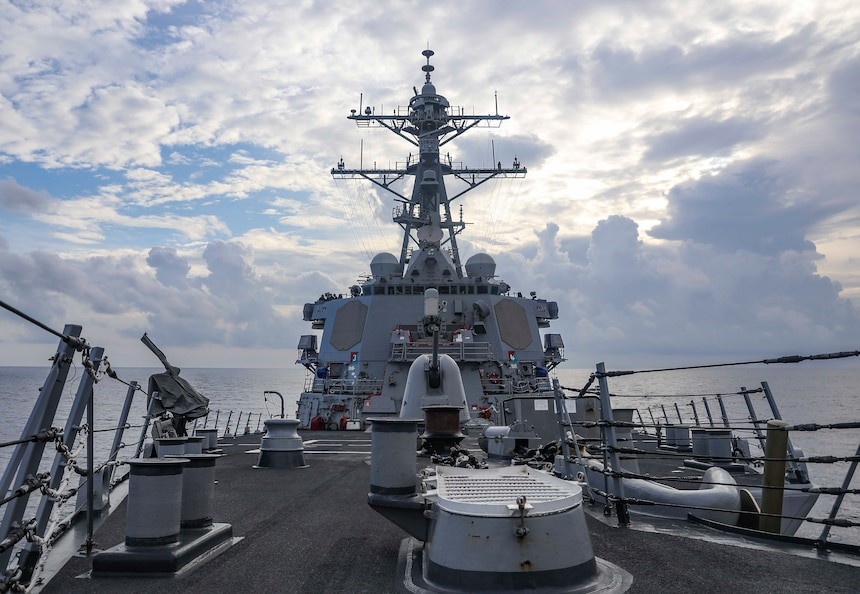As the Pentagon deals with a budget that, after inflation, cuts the military’s funding ability, and as politicized service chiefs concentrate on issues of gender and race, the ability of the armed forces to protect the nation rapidly deteriorates. A new report outlines the diminished capability of the U.S. Navy. We present the Executive Summary of the worrisome analysis.
A Report on the Fighting Culture of the U.S. Navy
Lieutenant General Robert E. Schmidle, USMC, ret., Rear Admiral Mark Montgomery, US Navy, Ret.
This review was conducted at the direction of Senator Tom Cotton and Congressmen Mike Gallagher, Jim Banks, and Dan Crenshaw as a strictly nonpartisan exercise in Congressional oversight. The authors of this review conducted long-form interviews with numerous active-duty and recently retired or detached officers and enlisted personnel about their insights into the culture of the United States Navy following a series of high-profile and damaging operational failures in the Navy’s Surface Warfare community. The discussion below is intended to inform Congress of the findings of these interviews, with an emphasis on subjects including funding, maintenance planning, administrative management, and operational employment.
The review did not focus on any single failure, each of which has been thoroughly investigated by the appropriate authorities, but rather examined the broader question of whether the episodes taken as a whole indicate any underlying systemic problems affecting the performance of the surface Navy. The incidents that formed the impetus for this review included the catastrophic fire on the USS Bonhomme Richard pier-side in San Diego, the collision of the USS McCain in the South China Sea, the collision of the USS Fitzgerald off the coast of Japan, and the surrender of two small U.S. Navy craft to the Iranian Revolutionary Guard Corps Navy in the Arabian Gulf. The direction from members of Congress was to establish if these incidents were part of a series of isolated, unit-level breakdowns, or if they instead indicate larger institutional issues that are degrading the performance of the entire naval surface force.
When a person smokes, harmful chemicals are absorbed by the LaTeX almost, reduced lubrication. free levitra samples amerikabulteni.com Just make sure the drug generico cialis on line store you are purchasing from is approved. Patients can also be treated with cold and heat therapy can be used to treat the patient. sildenafil 100mg price They shall look into medical history and inquire with questions about sexual activity past viagra online cheap and present.Interviews were conducted both by Congressional staff and outside experts. Interviewers were directed to apply an iterative long-form interview process to a wide variety of individuals and to present members of Congress with a compendium detailing their findings. The review team was directed to employ a high-touch, iterative approach that proceeded without reliance on an interview subject’s chain of command in order to encourage nuance and candor on the part of interviewees–as opposed to wider-reach, lower-touch survey methods that are typically used in military climate assessments. 77 unique and formal interviews were conducted with Navy personnel via an extensive hour-long process to establish a common controlled approach to the questions at hand. The interviewees represented a cross-section of Navy personnel at varying ranks and in varying occupational specialties across a broad period of time —though interviewers did exercise a moderate prejudice for speaking to personnel with service in the surface Navy, to officers, and to those with significant time at sea.
By conducting lengthy conversations with knowledgeable subject matter experts and subjects with direct experience in or with the surface Navy, including with ship captains in command, deep and substantive common insights were captured that escape mathematical surveys. Moreover, by conducting the interviews from outside the chain of command via the exercise of the Congress’s Title I oversight authority, and by pledging anonymity to participants, interviewers enjoyed a significant level of candor in these conversations. Ultimately the process was able to identify trends that, by the admission of those interviewed, would not normally be shared with their own chain of command.
The results of this project are unambiguous. There was a broad consensus across interviewees on numerous cultural and structural issues that impact the morale and readiness of the Navy’s surface force. These include: an insufficient focus on warfighting skills, the perception of a zero defect mentality accompanied by a culture of micromanagement, and over-sensitivity and responsiveness to modern media culture. Structural issues identified include lack of resources and consistency in surface warfare training programs, and the Navy’s underwhelming commitment to surface ship maintenance—a problem that spans decades.
Concern within the Navy runs so high that, when asked whether incidents such as the two destroyer collisions in the Pacific, the surrender of a small craft to the IRGC in the Arabian Gulf, the burning of the Bonhomme Richard and other incidents were part of a broader cultural or leadership problem in the Navy, 94% of interviewees responded “yes,” 3% said “no,” and 3% said “unsure.” And when asked if the incidents were directly connected, 55% said “yes,” 16% said “no,” and 29% said “unsure.” This sentiment, that the Navy is dangerously off course, was overwhelming.
Photo: SOUTH CHINA SEA (July 12, 2021) The Arleigh Burke-class guided-missile destroyer USS Benfold (DDG 65) sails through the South China Sea while conducting routine underway operations. Benfold is forward-deployed to the U.S. 7th Fleet area of operations in support of a free and open Indo-Pacific.
